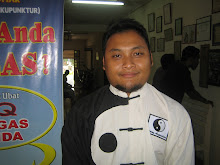

Acupuncture Courses In Malaysia
How To Apply
Department of Chinese Medicine - Acupuncture
Faculty of Homeopathy Malaysia ®
Main Campus: No.122 Taman Universiti, Kg Gelang Mas, Meranti
17010 Pasir Mas, Kelantan, Malaysia
Tel: 019-9401915
FAHOM Registration No: KT 0035017-H
Our Research Institute are running various type of courses to suit the individual need. For those who are very busy they may join the Intensive Course for basic understanding of Chinese Medicine in Acupuncture. While those who are going to be the full time practitioners, they need to join the Three Years Professional Programme. All courses will follow the syllabus adopted by The Beijing Academy of Chinese Medicine, China with the collaboration of WHO Nomenclature, and The International Standard of Certification In Acupuncture approved by most of the colleges all over the world.
Subjects Minimum Time ApprovedModule One
1. History of China and Acupuncture ( 5 Credit Hours )
2. Anatomy and Physiology ( 10 Credit Hours)
3. Acupuncture terminology ( 5 Credit Hours)
4. Theory Yin and Yang ( 5 Credit Hours)
5. Study of Meridians, Lung, Pericardium, Heart. ( 15 credit Hours )
6. Case Study ( 15 Credit Hours )
7. Examination Part 1 ( 1 Credit Hour )
Module Two
1. Study of Material and Technique ( 5 Credit Hours )
2. Contraindication and Prohibited ( 5 Credit Hours )
3. Dangerous Points ( 5 Credit Hours )
4. Theory of Five Elements ( 5 Credit Hours )
5. Study of Meridians, Large Intestine, Triple Warmer,
Small Intestine. ( 15 Credit Hours )
6. Clinical at our Hospital ( 10 Credit Hours )
7. Outdoor the Case taking ( 30 Credit Hours )
8. Examination Part 2 ( 1 Credit Hour )
Module Three
1. Needling - Type of Needles ( 5 Credit Hours - 1,000 needling)
2. Positions of Needling ( 5 Credit Hours )
3. Technique of Puncturing ( 5 Credit Hours )
4. Clinical at our Hospital. ( 10 Credit Hours )
5. Out door Case taking ( 30 Credit Hours )
6. Study of Meridian, Ren, Kidney, Spleen,
Gall Bladder ( 15 Credit Hours )
7. Examination Part 3 ( 1 Credit Hour )
Module Four
1. Stimulator and Stimulation, Laser, Cunometer ( 5 Credit Hours)
2. Moxibustion ( 5 Credit Hours )
3. Therapeutic ( 5 Credit Hours )
4. Clinical Practice at Hospital ( 10 Credit Hours )
5. Study of Meridians, DU, Urinary Bladder ( 15 Credit Hours )
6. Examination Part 4 ( 2 Credit Hours )
Type of Courses
Full Time / Distance Learning / Part Time *
Type of Course Duration Certificate Study Duration
Minimum
Basic Course - One week Intensive Course Cert.Acu. 30 Credit Hours
Diploma In Acupuncture - One Year D. Ac 150 Credit Hours
Master In Acupuncture ** - Three Years M.Ac 500 Credit Hours
Membership of Research Institute of Acupuncture MRIAc 150 Credit Hours
* Distance Learning is meant for foreign students or practitioners who are living far
away from our campus.
** For M.Ac ( Thesis Presentation)
Other Short Courses Offered:
Cupping / Blood Stasis / Bekam 2 days ( 16 Credit Hours )
Moxibustion and Related Subjects 2 days ( 16 Credit Hours )
Reflexology 2 days ( 16 Credit Hours )
Clinical Practice 7 days ( 36 Credit Hours )
Homoeopathy - Full Time / Part Time Course.
Basic Course - D.F.Hom 1 year ( 105 Credit Hours)
Advance Course - B.H.M.S. 4 years ( 420 Credit Hours )
Master Course - M.D.Hom 5 years ( 1000 Credit Hours )
Post Graduate in Homeopathy
M.F.Hom. Thesis Presentation ( 200 Credit Hours )
F.F.Hom Thesis Presentation ( 300 Credit Hours )
Application For Courses, please write to:
The Registrar,
The Faculty of Homeopathy Malaysia - FAHOM ®
No.122 Taman University, Gelang Mas, Meranti
17010 Pasir Mas, Kelantan, Malaysia
Tel: 019-9401915
E mail: fahom2@yahoo.com
Web http://www.homeopathymalaysia.org.my
Intake of Student : Open to all Malaysian / Foreigners. Lecture started first week of every month.
Medium of Instruction: : According to your choice either
English , Malay or Chinese.































